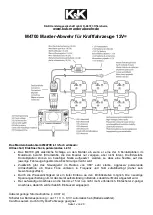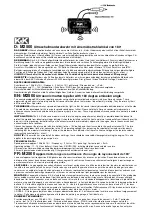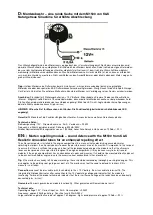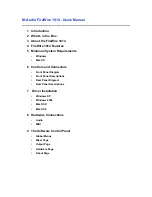
30
LCD Arm Mount Installation
¤
2005-2010 SR Research Ltd.
5.4
Mounting the EyeLink 1000 High-Speed Camera
The EyeLink 1000 LCD Arm Mount requires that the EyeLink 1000 Camera be attached. It may
have already shipped this way, or you may have to attach a camera that was part of a different
mounting system.
The Standard EyeLink 1000 Camera.
To affix the Standard EyeLink 1000 camera, first remove
the cover that obscures the camera and illuminator from the bottom front of the Camera and
LCD Assembly. Two thumbscrews on the underside of the assembly hold the cover in place –
simply loosen the thumbscrews and the cover will slide off in the forward direction.
Although not essential, it may be convenient to attach the CameraLink cable that emerges from
the LCD Arm to the back of the camera before attaching the camera. This is an opportune
point to attach this cable because once the camera is attached there is not a lot of space
between the cable interface on the back of the camera and the bracket holding the camera (see
top of Figure 5-4). The CameraLink cable is a D shaped cable that can only go in one
orientation, and requires thumbscrews to be tightened to assure a good connection. The
thumbscrews are also slotted so that a slotted screwdriver can be used to tighten the screws if
your thumbs are not strong enough to do the job.
The Fiber Optic Camera.
Put the Camera Head into the Camera Adaptor. Plug the fiber optic
extension cable (either a single cable or part of the Integrated Extension Cable) into the Camera
Head along with the 5V pressure-sensitive power connector. Plug the illuminator 3.5 mm (1/8”)
mini-plugs that emerge from the LCD Arm’s illuminator (male) into the sockets emerging from
the LCD Arm or from the Integrated Extension Cable (female). The other end of the fiber optic
cable and illuminator mini-plugs will plug into the Camera Base Box.
All EyeLink 1000 Cameras.
Mount the camera on the LCD assembly. On the front of the
camera is a threaded hole that the camera screw from the LCD Arm Mount will go into. This
will secure the camera. A knob is attached to the opposite side of the camera screw so that it is
easy to turn the screw into the camera hole. If there is not enough room for the camera
between the monitor and the camera assembly then more space can be gained by moving the
assembly further from the monitor. Undo the hex bolts holding the bracket with the camera
assembly to the monitor and move this forward (1 or 2 sets of holes) until there is enough room
for the camera to slip in between the monitor and the camera assembly. Retighten the hex
bolts and then proceed to attach the camera to the LCD assembly.
Dimples on the camera fit into protrusions on the mount in order to ensure the right
positioning of the camera, which should be aligned level with the top surface of the part of the
mount holding the camera screw. Tighten the knob until the camera is secured. Next replace
the cover by sliding the slots on the cover’s bottom around the thumbscrews on the underside
of the assembly. Tighten the thumbscrews and adjust the cover so that it is minimally
obscuring the IR illuminator and the camera.
















































